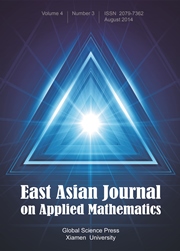Crossref Citations
This article has been cited by the following publications. This list is generated based on data provided by Crossref.
Zheng, Hua
and
Qu, Wei
2020.
Superlinearly convergent methods for solving a class of implicit complementarity problems based on sign analysis.
Japan Journal of Industrial and Applied Mathematics,
Vol. 37,
Issue. 2,
p.
433.
Li, Nan
Ding, Jian
and
Yin, Jun-Feng
2022.
Modified relaxation two-sweep modulus-based matrix splitting iteration method for solving a class of implicit complementarity problems.
Journal of Computational and Applied Mathematics,
Vol. 413,
Issue. ,
p.
114370.
Zheng, Hua
Zhang, Yongxiong
Lu, Xiaoping
and
Vong, Seakweng
2023.
Modulus-based synchronous multisplitting iteration methods for large sparse vertical linear complementarity problems.
Numerical Algorithms,
Vol. 93,
Issue. 2,
p.
711.
Zhang, Yongxiong
Zheng, Hua
Vong, Seakweng
and
Lu, Xiaoping
2023.
A two-step parallel iteration method for large sparse horizontal linear complementarity problems.
Applied Mathematics and Computation,
Vol. 438,
Issue. ,
p.
127609.
Zhang, Yongxiong
Zheng, Hua
Lu, Xiaoping
and
Vong, Seakweng
2023.
Modulus-based synchronous multisplitting iteration methods without auxiliary variable for solving vertical linear complementarity problems.
Applied Mathematics and Computation,
Vol. 458,
Issue. ,
p.
128248.
Wang, Lu-Xin
Cao, Yang
Shen, Qin-Qin
and
Zhou, Chen-Can
2024.
Two-step nonlinear modulus-based matrix splitting iteration method for implicit complementarity problems.
Numerical Algorithms,
Guo, Wenxiu
Zheng, Hua
Lu, Xiaoping
and
Zhang, Yongxiong
2024.
On the two-stage multisplitting iteration methods for linear complementarity problems.
Applied Mathematics and Computation,
Vol. 475,
Issue. ,
p.
128741.
Gao, Ke-Yu
and
Li, Chen-Liang
2024.
Modulus-Based Cascadic Multigrid Method for Quasi-variational Inequality Problems.
Communications on Applied Mathematics and Computation,
Mezzadri, Francesco
2025.
A modulus-based framework for weighted horizontal linear complementarity problems.
Applied Mathematics and Computation,
Vol. 495,
Issue. ,
p.
129313.


